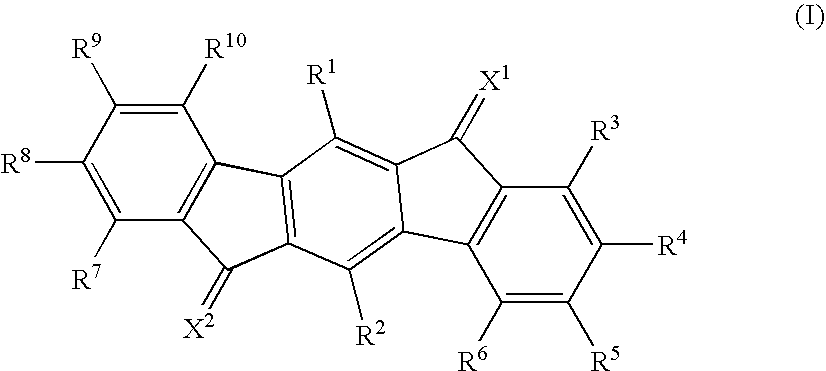Material for organic electroluminescence device and organic electroluminescence device
a technology of electroluminescence device and material, which is applied in the direction of luminescnet screens, discharge tubes, organic chemistry, etc., can solve the problems of increased consumption power, shortening device life, and shortened device life, and achieves small steric hindrance, thermal stability, and maintain the effect of molecular planarity
- Summary
- Abstract
- Description
- Claims
- Application Information
AI Technical Summary
Benefits of technology
Problems solved by technology
Method used
Image
Examples
example 1
Synthesis of a Compound Shown by the Formula (A-1)
[0231]The compound (A-1) was synthesized by the following synthesis scheme.
[0232]
(1) Synthesis of Intermediate A
[0233]2.2 g of 3,9-dibromo-indenofluorenedione prepared according to a synthesis method described in a document (Organic Letters, vol. 7, issue 19, page 4229) was mixed with 2.1 g of 4-(trifluoromethyl)phenylboronic acid, 0.14 g of tris(dibenzylideneacetone)dipalladium (0), 0.091 g of tris-t-butylphosphine, 1.9 g of potassium fluoride and 40 ml of toluene under argon stream. The mixture was stirred with reflux for 8 hours. After cooling, the reaction liquid was filtered and a reddish purple solid was washed with water and methanol. As a result of mass spectroscopy of the resulting solid, a peak was observed at M / Z=570.
(2) Synthesis of Compound (A-1)
[0234]2.0 g of the intermediate A which had been synthesized before was dissolved in 100 ml of methylene chloride with stirring. After making the atmosphere of the inside of the ...
example 2
Synthesis of a Compound Shown by the Formula (A-2)
[0239]
[0240]1.5 g of the intermediate A which had been synthesized before, 0.35 g of malononitrile and 80 ml of pyridine were added, and the resultant was heated with stirring at 90° C. for 8 hours. After cooling, the solid matter was filtered, washed with water and methanol, and dried under reduced pressure. Thereafter, purification through sublimation was performed to obtain 1.2 g of a purple crystal.
[0241]The IR of this compound was measured. The results showed that the absorption of a carbonyl group disappeared and the absorption of a cyano group was newly observed at 2222 cm−1. As a result of mass spectroscopy, a peak was observed at M / Z=666.
[0242]In the same manner as in Example 1, the reduction potential of this compound was measured by cyclic voltammetry. When the first oxidation potential of ferrocene (hereinafter referred to as the “Fc”) was taken as a reference potential, the reduction potential of the compound (A-2) was −...
example 3
Synthesis of a Compound Shown by the Formula (A-15)
[0243]The compound (A-15) was synthesized from the compound shown by the following formula B.
[0244]
[0245]In the synthesis of the compound (A-1) in Example 1, the same procedure was performed except that the intermediate A was changed to 1.1 g of the compound B, whereby 0.8 g of an orange solid as compound (A-15) was obtained.
[0246]The IR of this compound was measured. The results showed that the absorption of a carbonyl group disappeared and the absorption of a cyano group was newly observed at 2181 cm−1. As a result of mass spectroscopy, a peak was observed at M / Z=366.
[0247]The reduction potential of this compound was measured in the same manner as in Example 1 and found to be −0.7V (vs Fc+ / Fc).
PUM
| Property | Measurement | Unit |
|---|---|---|
| reduction potential | aaaaa | aaaaa |
| ionization energy | aaaaa | aaaaa |
| electric field | aaaaa | aaaaa |
Abstract
Description
Claims
Application Information
 Login to View More
Login to View More - R&D
- Intellectual Property
- Life Sciences
- Materials
- Tech Scout
- Unparalleled Data Quality
- Higher Quality Content
- 60% Fewer Hallucinations
Browse by: Latest US Patents, China's latest patents, Technical Efficacy Thesaurus, Application Domain, Technology Topic, Popular Technical Reports.
© 2025 PatSnap. All rights reserved.Legal|Privacy policy|Modern Slavery Act Transparency Statement|Sitemap|About US| Contact US: help@patsnap.com



